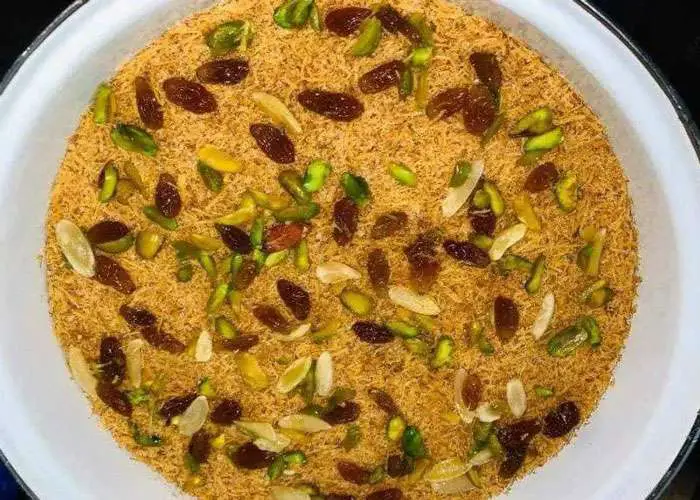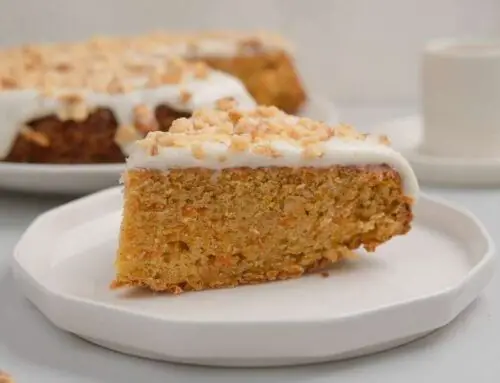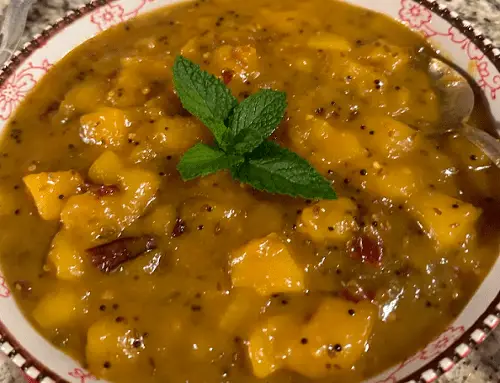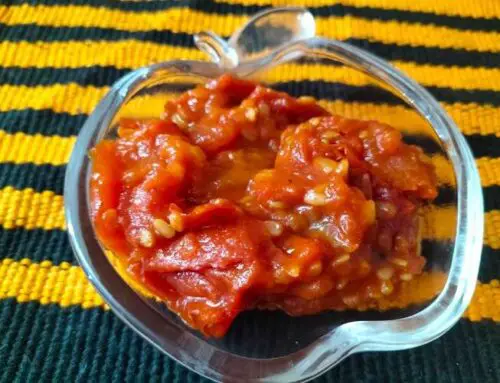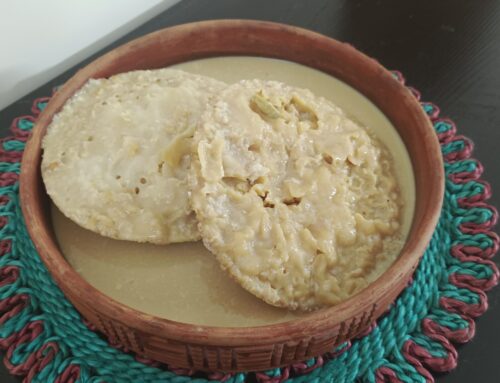Bengali cuisine is a tapestry of flavors that is richly woven with tradition and history. Among the many culinary treasures that grace its table, one dish stands out as a true emblem of celebration and indulgence: Kunafa. This exquisite dessert holds a cherished place in Bengali weddings and festive occasions, symbolizing not only the artistry of culinary expertise but also the warmth of communal gatherings.
Kunafa, a dessert that transcends its ingredients to become an experience, is crafted from vermicelli-like pastry threads, commonly known as “seviyan.” These delicate strands are meticulously layered with ghee, forming a base that melts in the mouth, releasing a sumptuous blend of textures and aromas. A rich filling of khoya (reduced milk solids), embellished with fragrant cardamom, saffron, and perhaps a scattering of nuts, is lovingly enveloped within the golden embrace of the seviyan. This symphony of flavors is then gently baked, resulting in a dessert that is as captivating to the eyes as it is to the palate.
Kunafa has become synonymous with Bengali weddings, an event where traditions and modernity coalesce. The dessert’s presence at these joyous occasions underscores its role in not just satisfying the sweet tooth but also in symbolizing the essence of unity and togetherness. As relatives, friends, and acquaintances come together to celebrate, Kunafa takes center stage, evoking a sense of shared delight and abundance.
However, Kunafa’s prominence goes beyond its appearance at weddings. It holds a special place in Bengali cuisine as one of its most cherished dishes. Every bite of Kunafa carries with it the heritage of a culinary journey that has been refined and perfected over generations. The dessert’s roots can be traced to Middle Eastern origins, where it is known as “kunafeh” or “knafeh.” The dish traveled across cultures and borders, adapting and evolving as it was embraced by different regions. In Bengal, Kunafa underwent a transformation, marrying its intrinsic flavors with the Bengali affinity for sweetness and textures.
Speaking of culinary treasures, no exploration of Bengali cuisine would be complete without acknowledging the iconic Biryani. This fragrant rice dish, replete with tender meat, aromatic spices, and fragrant saffron, encapsulates the essence of Bengali indulgence. Biryani’s history is steeped in royal narratives, a tale of culinary creativity born in the regal kitchens of the Mughal emperors. The dish traveled to Bengal during the era of Nawabs, who introduced it to the region. Over time, Bengali Biryani developed its own distinct character, with the use of fragrant Gobindobhog rice, succulent pieces of mutton or chicken, and the unique blend of spices that imparts an unparalleled depth of flavor.
The evolution of Biryani reflects the dynamic nature of culinary traditions, where regional influences meld with historical narratives to create a dish that is both nostalgic and tantalizing. Like Kunafa, Biryani has become a centerpiece of special occasions, weaving a tapestry of flavors that captures the essence of Bengal’s rich gastronomic heritage.
In conclusion, Bengali cuisine is an embodiment of culture, history, and celebration, and dishes like Kunafa and Biryani stand as testament to this fact. Kunafa’s delicate layers and aromatic fillings evoke a sense of unity and joy in Bengali weddings, while Biryani’s regal origins and evolving adaptations speak to the dynamic nature of culinary traditions. With each bite of these dishes, one not only experiences the artistry of flavors but also delves into the heart of Bengal’s culinary legacy – a legacy that continues to thrive with every feast, every gathering, and every celebration.
Kunafa
My name is Naina Zaman. Cooking has become my recent favorite activity, but when I was little, I enjoyed engaging in small household chores, including cooking. I believe that from that initial spark, my interest in cooking has been growing day by day.
Ingredients
- 1/2 cup butter
- 1 packet laccha shemai vermicelli
- 3 tbsp powdered milk
- 1 cup sugar
- 1 litre milk
- 1/3 cup full cream
- cardamom powder
- corn flour
- almonds
- raisins kismis
- cashews and almonds kaju badam
Instructions
- In a nonstick pan, melt butter.
- Add laccha shemai, powdered milk, and sugar to the melted butter. Sauté until they are fried and well-mixed.
- Boil 1 litre of milk and reduce it to half.
- Add full cream, cardamom powder, sugar, and corn flour to the reduced milk. Boil until the mixture thickens. Set it aside to cool down.
- Take a serving dish for the kunafa.
- Place the first half of the fried laccha shemai at the bottom of the dish.
- Pour the cooled down milk mixture (batter) over the shemai layer.
- Place the remaining laccha shemai on top of the milk layer.
- Sprinkle almonds, raisins (kismis), and cashews/almonds (kaju badam) on top of the shemai layer.
- Serve and enjoy the delicious Kunafa!
Nutrition

